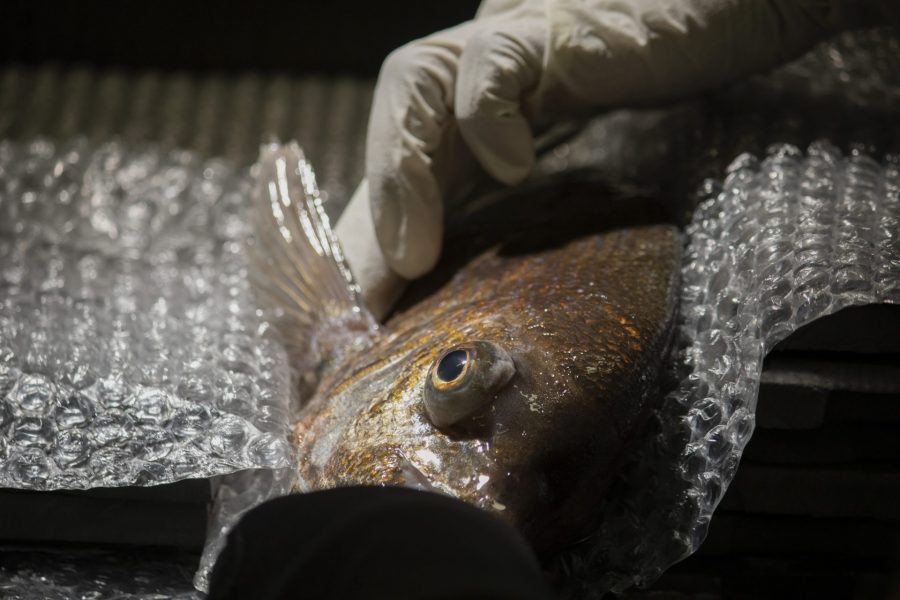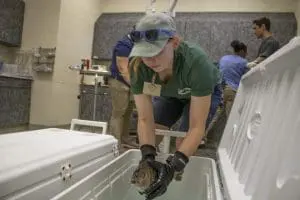

One of our pinfish recently needed surgery to remove their eye. The fish, lovingly named Popeye, is doing well!
Editor’s Note: This story describes removing an eye from a fish and includes photos of parts of this procedure.
Have you ever wondered how fish undergo surgery?
While there are a lot of similarities between surgery for a fish and a mammal, as expected, their unique anatomy requires some accommodations during surgery.
One of our pinfish, who has lovingly been renamed Popeye, was recently found in their “Indian River Lagoon” habitat at the Zoo’s Paws On area by their animal care team with a severely bulging eye. We do not know Popeye’s sex, so we are referring to Popeye as “they” in this blogpost! This injury was likely caused by some trauma, like hitting it against something. Unfortunately, the eye was causing Popeye pain, so the decision was made to remove the eye.
 Popeye was brought to our L3Harris Animal Hospital in a large cooler of water outfitted with an air pump. Our Herps and Aquatics team brought several air pumps for the procedure, along with a cooler to anesthetize Popeye in, a cooler for Popeye to recover in, and 10 gallons for the wet table anesthetic. To sedate Popeye, the anesthetic was added to the water in that particular cooler.
Popeye was brought to our L3Harris Animal Hospital in a large cooler of water outfitted with an air pump. Our Herps and Aquatics team brought several air pumps for the procedure, along with a cooler to anesthetize Popeye in, a cooler for Popeye to recover in, and 10 gallons for the wet table anesthetic. To sedate Popeye, the anesthetic was added to the water in that particular cooler.
Beforehand, our veterinary team created the surgery site: two sets of cut-up foam mats to wedge Popeye in between on the wet table. Bubble wrap was draped over the columns to not disturb Popeye’s scales and mucus coat, an important defensive layer of the skin designed keep fish healthy.
Once sedated, Popeye was brought to the surgery site. A hose of running water was carefully inserted in their mouth to keep them breathing. Fish get their oxygen in water, taking water in their mouth and pulling oxygen molecules from it using their gills. One of our veterinary nurses, Leatitia Bedminster, monitored Popeye’s heart rate throughout the procedure, and our Herps and Aquatics team was also on hand to ensure Popeye was getting a sufficient amount of water through the gills.
With the hose all set, veterinary intern Dr. Kaitlyn Cashin began carefully cutting through the muscle surrounding the eye before removing the eye itself along with some of the optic nerve.
Most fish don’t have eyelids, said Dr. Cashin, so unlike a dog or cat where when an eyeball is removed the eyelids are sutured back over, the site remains open and skin will grow over the site in the next few weeks! A gel bandage was applied to the socket to protect the area and promote healing. Popeye was placed into another cooler of clean water to begin coming out of the anesthesia.
Popeye is still recovering with antibiotics and pain medication, with their animal care team monitoring them for any signs of pain or stress like refusing to eat or hiding. We’re hopeful Popeye will be back in the Zoo’s Indian River Lagoon habitat soon!
Brevard Zoo is an independent, not-for-profit organization that receives no recurring government funding for our operating costs. Your generous support enables us to continue to serve our community and continue our vital animal wellness, education and conservation programs.